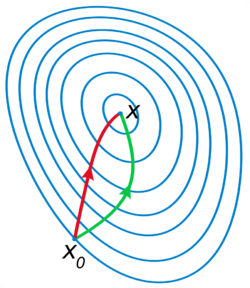🔬 Tutorial problems iota \(\iota\)#
Note
This problems are designed to help you practice the concepts covered in the lectures. Not all problems may be covered in the tutorial, those left out are for additional practice on your own.
\(\iota\).1#
Solve the following constrained maximization problem using the Karush-Kuhn-Tucker method. Verify that the found stationary/critical points satisfy the second order conditions.
The constraint is \(g(x,y) := x^2-y^2 - 1 \le 0\). The Lagrangian function is
The necessary KKT conditions are given by the following system of equations and inequalities
To solve this system, we start from checking the two possible cases: \(\lambda=0\) and \(\lambda>0\).
Case 1. \(\lambda=0\): the constraint could not be binding. Then, the FOCs imply \(x=y=0\). The unconstrained Hessian matrix is
We have \(\det(H)=0\) and \(trace(H)=0\) so that there is no sufficient information to conclude the property of the stationary point.
Case 2. \(\lambda>0\): the constraint is binding. Then, the problem is the optimization with equality constraint, given two control variables \(N=2\) and one constraint \(K=1\). From the FOCs, we have
Since further we have the constraint \(x^2+y^2=1\), there are three cases: “\(x=0, y<0\)”, “\(x>0, y=0\)” or “\(x>0, y<0\)”.
(i) If \(x>0, y<0\), then it follows from the above conditions that
Since \(x^2+y^2=1\) and \(x>0, y<0\), we have \(x=1/\sqrt{2}, y=-1/\sqrt{2}\) and then \(\lambda= 3/(2\sqrt{2})\).
Observe that \(\mathrm{rank}(Dg)) = \mathrm{rank}((2x, 2y)) = 1\) for \(x \ne 0\) or \(y\neq0\), so the constrained qualification holds for any point on the boundary.
The bordered Hessian matrix is
Now, the bordered Hessian at \((x,y,\lambda) = (1/\sqrt{2}, -1/\sqrt{2}, 3/(2\sqrt{2}))\) is
It suffices to check the last leading principal minor. The determinant is
which has the same sign as \((-1)^K=(-1)\). Therefore, it is positive definite and we have a local minimum on the boundary.
(ii) If \(x=0, y<0\), then from \(x^2+y^2=1\), we have \(y=-1\). Also, \(\lambda=-3y/2 = 3/2\). The border Hessian is
The determinant is \(\det (H\mathcal{L})=12 >0\), which has the same sign as \((-1)^2\) and then the Hessian matrix is negative definite. Therefore, \((0, -1)\) is a local maximum.
(iii) If \(x>0, y=0\), then from \(x^2+y^2=1\), we have \(x=1\). Also, \(\lambda=3x/2 = 3/2\). The border Hessian is
The determinant is \(\det (H\mathcal{L})=12 >0\), which has the same sign as \((-1)^2\) and then the Hessian matrix is negative definite. Therefore, \((1, 0)\) is a local maximum.
Finally, the objective values for the local maximums are \(f(1,0)=f(0,-1)=1\) and note that the constrained set is compact. Therefore, these two local maximizers are also global maximizers.
\(\iota\).2#
Solve the following constrained maximization problem using the Karush-Kuhn-Tucker method. Verify that the found stationary/critical points satisfy the second order conditions.
The Lagrangian function is
KKT conditions are
Case 1: \(\lambda = 0\)
This is the unconstrained case with the number of variables \(N=2\). KKT conditions simplify to
Thus, \(x=0\), but then \(y^2+2>0\) for any \(y\), and therefore the inequality is violated. We conclude that \(\lambda=0\) is not a solution.
Case 2: \(\lambda > 0\)
This is a constrained case with the number of variables \(N=2\) and number of binding constraints equal \(K=1\). KKT conditions simplify to
The last equation simplifies to \((x - y)(x+y) -2xy - 2 = -2(xy+1) = 0\), and thus \(xy+1=0\). Combining the last equation with \(y + x = 0\), we have
Then, the two stationary points are \((x,y) = (1,-1)\) and \((x,y) = (-1,1)\), with \(\lambda = x/(x-y) = 1/2\) for both points.
Let’s check the second-order conditions for each of these points:
\((x,y) = (1,-1)\), \(\lambda=1/2\)
The boarded Hessian is
We first have to check \(N-K=1\) determinant of the bordered Hessian, no rows/columns to be removed:
The sign of the full determinant is the same as \((-1)^N\), the alternation sequence of one element is satisfied trivially, thus we conclude that the relevant quadratic form is negative definite, and thus point \((1,-1)\) is a local maximizer.
\((x,y) = (-1,1)\), \(\lambda=1/2\)
The boarded Hessian is
Similar to the previous point, we have
Again, we conclude that at point \((-1,1)\) the objective function attains a local maximum.
Finally, to find the global maximum, we can compare the values of the objective function at the stationary points:
\(f(1,-1) = - 1^2 = -1\)
\(f(-1,1) = - (-1)^2 = -1\)
Thus, the problem has two global maximizers which coincide with the two found local constrained maximizers \((1,-1)\) and \((-1,1)\).
